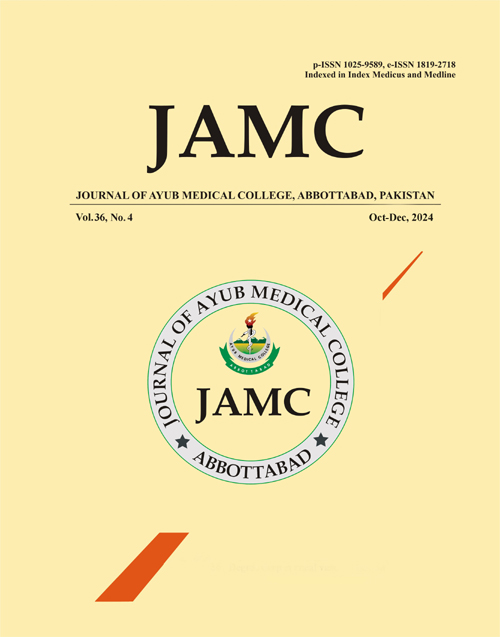AN AUDIT OF OXYGEN PRESCRIBING PRACTICES IN RESPIRATORY WARDS OF A TERTIARY CARE HOSPITAL IN NOTTINGHAMSHIRE, UK
DOI:
https://doi.org/10.55519/JAMC-04-12375Keywords:
Oxygen inhalation therapies, electronic prescribing, drug prescription, respiratory failureAbstract
Background: This audit primarily assesses compliance with the British Thoracic Society guidelines (BTS) for oxygen prescriptions in the Respiratory Department at King’s Mill Hospital. The results of this audit aim to guide the strategies to improve the oxygen prescription practices in the Trust. Methods: We collected the data on oxygen prescriptions, from the electronic prescribing system, of all the patients admitted in the three respiratory wards of King’s Mill Hospital over the period of one week. This data was then recorded and analysed using Audit management and Tracking© (AMAT). Results: The overall compliance score to BTS guidelines for oxygen prescription was 12.2%. Out of the 152 patients, only 8 (5%) had oxygen therapy prescribed and a target oxygen saturation range was identified. No patient had an identifiable oxygen delivery method on their prescription. Conclusion: The current practices of oxygen prescription at the respiratory department of King’s Mill Hospital are suboptimal. These findings highlight the risk of serious potential consequences and the opportunity to implement safe prescribing measures for oxygen, like other prescribed medications.
References
1. Bitterman H. Bench-to-bedside review: Oxygen as a drug. Crit Care 2009;13(1):205.
2. Echevarria C, Steer J, Wason J, Bourke S. Oxygen therapy and inpatient mortality in COPD exacerbation. Emerg Med J 2021;38(3):170–7.
3. Chu DK, Kim LHY, Young PJ, Zamiri N, Almenawer SA, Jaeschke R, et al. Mortality and morbidity in acutely ill adults treated with liberal versus conservative oxygen therapy (IOTA): a systematic review and meta-analysis. Lancet 2018;391(10131):1693–705.
4. O’Driscoll BR, Howard LS, Earis J, Mak V. BTS guideline for oxygen use in adults in healthcare and emergency settings. Thorax 2017;72(Suppl 1):ii1–90.
5. O’Driscoll BR, Howard LS, Bucknall C, Welham SA, Davison AG, British Thoracic Society. British Thoracic Society emergency oxygen audits. Thorax 2011;66(8):734–5.
6. Ranjbar H, Dorai S. Improvements and Shortcomings in Emergency Oxygen Prescribing: A Quality Improvement Initiative at an Acute Tertiary Care Hospital. EMJ 2021;135:1–6.
7. Duke T, Graham SM, Cherian MN, Ginsburg AS, English M, Howie S, et al. Oxygen is an essential medicine: a call for international action. Int J Tuberc Lung Dis 2010;14(11):1362–8.
8. Bell C. Is this what the doctor ordered? Accuracy of oxygen therapy prescribed and delivered in hospital. Prof Nurse 1995;10(5):297–300.
9. Austin MA, Wills KE, Blizzard L, Walters EH, Wood-Baker R. Effect of high flow oxygen on mortality in chronic obstructive pulmonary disease patients in prehospital setting: randomised controlled trial. BMJ 2010;341:c5462.
10. Cooper JS, Phuyal P, Shah N. Oxygen Toxicity. In: StatPearls [Internet]. Treasure Island (FL): StatPearls Publishing; 2023 [cited 2023 Aug 9]. Available from: http://www.ncbi.nlm.nih.gov/books/NBK430743/
11. Lomas J, Anderson GM, Domnick-Pierre K, Vayda E, Enkin MW, Hannah WJ. Do practice guidelines guide practice? The effect of a consensus statement on the practice of physicians. N Engl J Med 1989;321(19):1306–11.
12. Taheri Moghadam S, Sadoughi F, Velayati F, Ehsanzadeh SJ, Poursharif S. The effects of clinical decision support system for prescribing medication on patient outcomes and physician practice performance: a systematic review and meta-analysis. BMC Med Inform Decis Mak 2021;21(1):98.
13. Devoe NC, Kyriazis P, Eltanbedawi A, Contractor A, Esposito AW, Khan MS, et al. An audit of oxygen supplementation in a large tertiary hospital - we should treat oxygen as any other drug. Hosp Pract (1995) 2021;49(2):100–3.
14. Zeserson E, Goodgame B, Hess JD, Schultz K, Hoon C, Lamb K, et al. Correlation of Venous Blood Gas and Pulse Oximetry with Arterial Blood Gas in the Undifferentiated Critically Ill Patient. J Intensive Care Med 2018;33(3):176–81.
Downloads
Published
How to Cite
Issue
Section
License
Copyright (c) 2024 Hassan Ahmed, Kruthika Nataraju, Ahmed A Elmahdy, Muhammad Afrasiyab Cheema

This work is licensed under a Creative Commons Attribution-NoDerivatives 4.0 International License.
Journal of Ayub Medical College, Abbottabad is an OPEN ACCESS JOURNAL which means that all content is FREELY available without charge to all users whether registered with the journal or not. The work published by J Ayub Med Coll Abbottabad is licensed and distributed under the creative commons License CC BY ND Attribution-NoDerivs. Material printed in this journal is OPEN to access, and are FREE for use in academic and research work with proper citation. J Ayub Med Coll Abbottabad accepts only original material for publication with the understanding that except for abstracts, no part of the data has been published or will be submitted for publication elsewhere before appearing in J Ayub Med Coll Abbottabad. The Editorial Board of J Ayub Med Coll Abbottabad makes every effort to ensure the accuracy and authenticity of material printed in J Ayub Med Coll Abbottabad. However, conclusions and statements expressed are views of the authors and do not reflect the opinion/policy of J Ayub Med Coll Abbottabad or the Editorial Board.
USERS are allowed to read, download, copy, distribute, print, search, or link to the full texts of the articles, or use them for any other lawful purpose, without asking prior permission from the publisher or the author. This is in accordance with the BOAI definition of open access.
AUTHORS retain the rights of free downloading/unlimited e-print of full text and sharing/disseminating the article without any restriction, by any means including twitter, scholarly collaboration networks such as ResearchGate, Academia.eu, and social media sites such as Twitter, LinkedIn, Google Scholar and any other professional or academic networking site.










